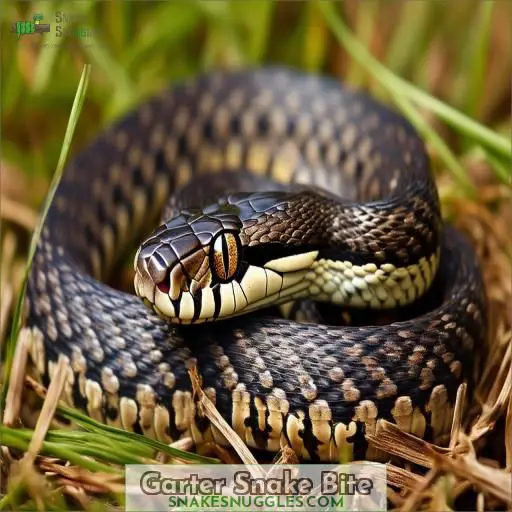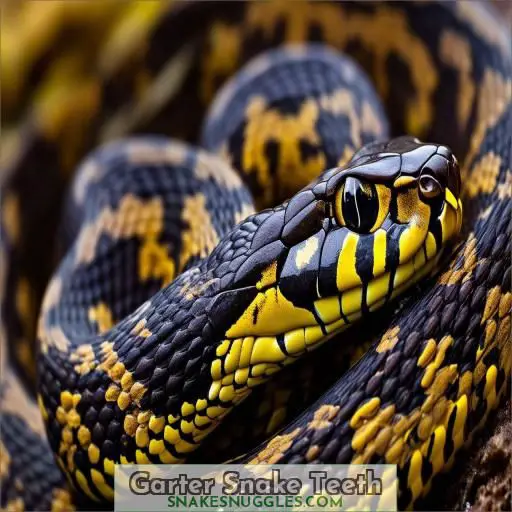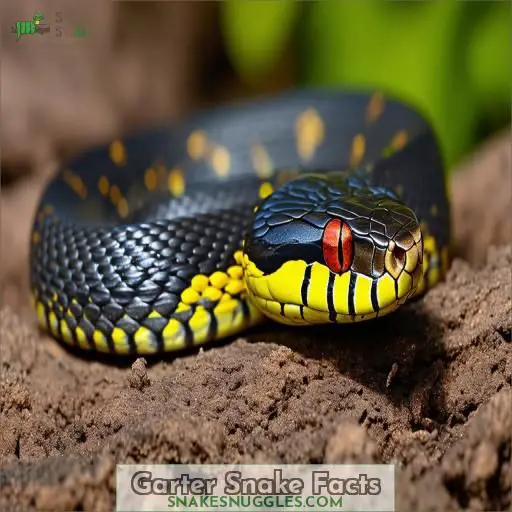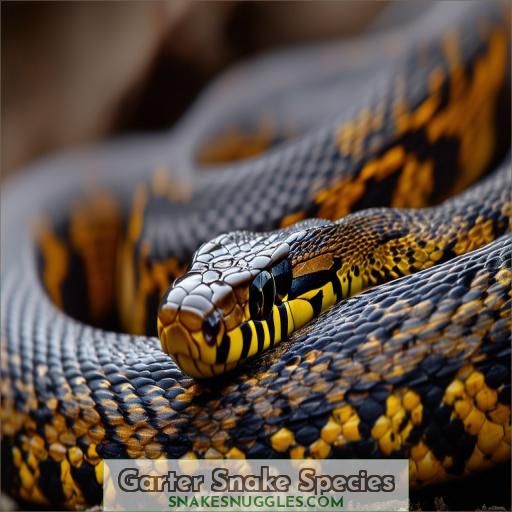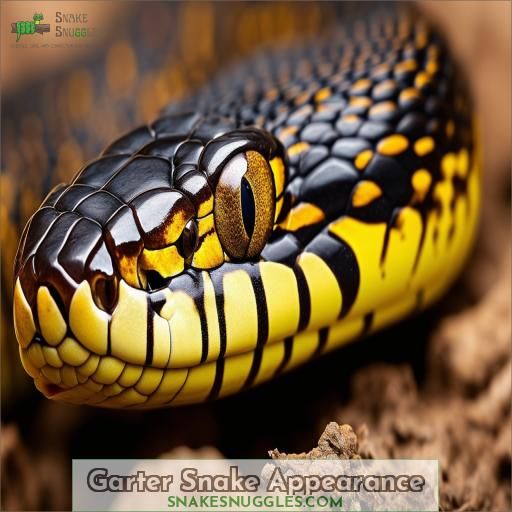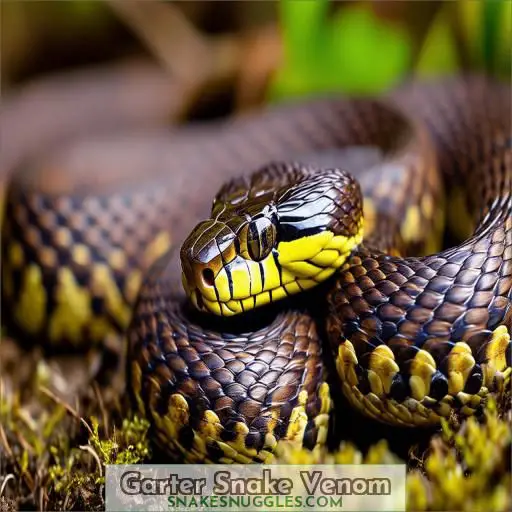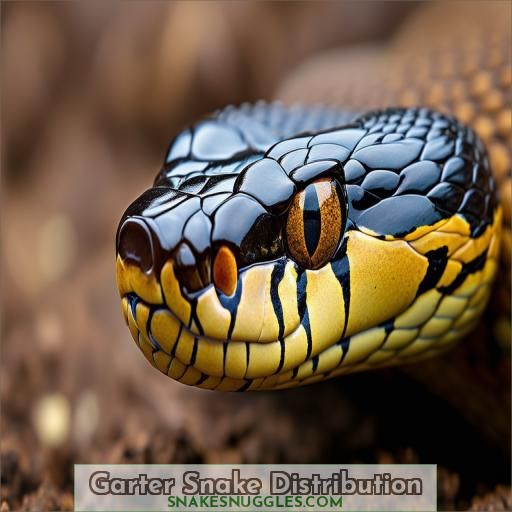This site is supported by our readers. We may earn a commission, at no cost to you, if you purchase through links.
 You’re curious about common garter snakes’ size, bite, and other essential facts?
You’re curious about common garter snakes’ size, bite, and other essential facts?
Let me enlighten you.
These slender serpents range from 23 inches to 5 feet long, with males slightly smaller than females.
Their tiny teeth and mildly toxic saliva help subdue prey but pose minimal risk to humans.
A bite might cause swelling, so clean it properly.
Garter snakes play vital roles as rodent controllers and amphibian predators across diverse habitats.
Intrigued? I’ve merely scratched the surface – continue, and you’ll uncover a fascinating world of garter snake wonders.
Table Of Contents
- Key Takeaways
- Garter Snake Size
- Garter Snake Bite
- Garter Snake Teeth
- Garter Snake Reproduction
- Garter Snake Facts
- Garter Snake Species
- Garter Snake Appearance
- Garter Snake Venom
- Garter Snake Distribution
- Garter Snake Conservation
- Frequently Asked Questions (FAQs)
- What is the size of a common garter snake?
- What does a garter snake bite?
- How big are garter snakes in inches?
- How many teeth do garter snakes have?
- How long do garter snakes typically live?
- What predators prey on garter snakes?
- Can garter snakes be kept as pets?
- Do garter snakes hibernate during winter?
- How do garter snakes attract mates?
- Conclusion
Key Takeaways
- While their bite may cause a bit of swelling, these mildly venomous noodly friends pose next to no threat to us humans. Still, it’s wise to treat any snakebite with care – clean that sucker up good, and keep an eye out for potential infection.
- These slinky serpents come in a kaleidoscope of colors and patterns – from classic stripes to vibrant hues that’ll make your eyes pop. And get this – their snazzy scales are like nature’s body armor, with groovy little ridges to help them slither and climb with ease. Talk about fashion and function!
- Imagine stumbling upon a "mating ball" of garter snakes – a tangle of hormonal dudes all vying for that special lady’s affection. It’s like a real-life romantic comedy, minus the cheesy one-liners. These frisky fellows put on quite the courtship display!
- From backyard gardens to lush meadows, garter snakes are the versatile guests you didn’t know you needed. These eco-warriors keep pest populations in check, making them the unsung heroes of many an ecosystem. Give a snake a hand…or just leave them be to do their thing.
Garter Snake Size
You’ll find garter snakes range widely in size, with adults typically measuring between 2-4 feet long. However, their length can vary substantially, from a mere 23 inches to an impressive 5 feet!
This size variation depends on the species, sex, age, and environmental conditions. Generally, males are slightly smaller than females – a quirk of sexual dimorphism.
Garter snakes have slender to moderately stout bodies, with their thickness affected by recent meals. As juveniles, they start off quite slim but steadily grow thicker and longer over time.
Monitoring a garter snake’s size offers insights into its health, diet, and maturity level.
Garter Snake Bite
While garter snakes have small teeth and can bite, their bites aren’t dangerous to humans – though they can still cause pain, swelling, and potential infection if not properly cleaned.
You should always exercise caution around any snake to avoid potential bites.
If bitten, clean the wound thoroughly with soap and water, apply an antiseptic, and monitor for signs of infection like increasing redness, swelling, or pus. Seek medical attention if symptoms persist or worsen.
Taking precautions like wearing gloves when handling garter snakes and giving them space can prevent bites altogether.
Garter Snake Teeth
You should know that garter snakes have dozens of tiny teeth on both their upper and lower jaws.
While not venomous, their saliva contains a mild toxin that can cause localized swelling or irritation if bitten.
These snakes usually only bite in self-defense or when handled roughly.
Proper hygiene prevents infections if bitten.
Their teeth help subdue prey like frogs, worms, and small mammals by gripping tightly.
Some species show color variations in their teeth based on diet.
Despite their small size, garter snake teeth play a crucial role in their ecological impact as rodent controllers and amphibian predators.
Garter Snake Reproduction
Concerning reproduction, garter snakes engage in fascinating breeding rituals. In spring, you might witness large "mating balls" where multiple males vie for a single female. Once mated, the female carries her young for around 3-4 months before giving birth to:
- Live offspring, a trait called ovoviviparity
- Up to 85 baby snakes in a single litter
- Newborns measuring 5-8 inches at birth
Males and females mate annually, with subspecies exhibiting slight variations. Despite lacking ritualized parental care, garter snake reproduction is a gripping drama of survival where predators, competition, and environmental factors shape each new generation.
Garter Snake Facts
Garter snakes are found across various habitats, from woodlands and meadows to suburban areas, often near water sources. Their diet consists primarily of amphibians, earthworms, insects, and small mammals, which they subdue with their mildly toxic saliva before swallowing whole.
Habitat
You’ll find garter snakes inhabiting diverse environments across North America, from woodlands and meadows to suburban backyards. These opportunistic serpents thrive near water sources, nesting under logs or rocks. While widespread, some populations face threats like habitat loss and human persecution, underscoring the need for conservation efforts to protect their habitats.
Diet
You’ll find garter snakes feast on a variety of prey such as frogs, toads, insects, earthworms, and even small rodents. These opportunistic hunters will consume whatever suitable prey is available in their environment. However, they typically hunt during the day, stalking and seizing their quarry with lightning reflexes. Understanding their diverse diet provides valuable insight into their ecological role.
Behavior
You’ll often spot garter snakes basking in the sun to regulate body temperature.
They’re generally active during the day, hunting for prey like insects, frogs, and small mammals.
Come spring, you may witness their intricate courtship rituals as males compete for mates through displays of body undulations and combat.
These fascinating snakes communicate through pheromones and exhibit surprising intelligence in navigation and problem-solving.
Garter Snake Species
You’re likely familiar with the iconic striped pattern of the common garter snake, but did you know there are actually many distinct species within this group? Each adapted to different environments and facing unique challenges:
- Eastern Garter Snake: One of the most widespread, found across eastern North America
- California Red-Sided Garter Snake: Restricted to the West Coast, threatened by habitat loss
- Red-Spotted Garter Snake: Endangered due to climate change impacts on its wetland homes
- Over 20 other subspecies occupy diverse niches across the continent
Understanding the evolutionary relationships and threats facing each species is critical for their conservation. These snakes play indispensable roles in ecosystems and hold cultural significance for many communities.
Garter Snake Appearance
Garter snakes display a wide variety of colors and patterns, with the classic appearance featuring three longitudinal stripes—one down the center of the back and one along each side. Their bodies are slender yet sturdy, with keeled scales that give them a rough texture and help with grip when climbing vegetation or moving through dense underbrush.
Colors and Patterns
Garter snakes showcase an array of stripe variations and color differences across species. Their patterns evolve regionally for effective camouflage – from the red-sided garter’s vivid hues to the muted tones of the San Francisco or New Mexico subspecies. The Puget Sound garter boasts a striking black-and-yellow pattern, while common garters sport classic stripes on brown or green backdrops.
Body Shape
Imagine running your hands along a common garter snake‘s body – you’ll feel keeled scales, with ridges lining each scale laterally. Garters have slender, elongated builds, though their body proportions and overall size varies across species. Some sport nearly smooth scales while others display intricate patterns, each unique to their environment.
Garter Snake Venom
You might be wondering about garter snake venom. While they’re not venomous in the typical sense, their saliva does contain a mild neurotoxin.
If bitten, some people experience swelling, burning, or itching. However, garter snake bites aren’t life-threatening. Their tiny teeth can barely break skin, but any bite should be cleaned properly.
Garter snakes are generally harmless, so handling them carefully or leaving them alone is best. Those with allergies may have more severe reactions.
Garter Snake Distribution
- They range from coast to coast, inhabiting most of Canada and the U.S. (except parts of the Southwest)
- You’re likely to spot them near water sources like streams, ponds, and drainage ditches
- Their adaptability lets them thrive everywhere from suburban gardens to forests and prairies
- Unique species include the Chicago garter (a city-dweller), maritime garter (coastal expert), and Texas garter (desert survivor)
No matter where you encounter these helpful garden snakes, watch in awe as they go about controlling pests through their impressive hunting prowess.
Garter Snake Conservation
Moving on from their wide distribution across North America, let’s talk about garter snake conservation. You’re probably wondering why these abundant snakes need protection. Well, despite their prevalence, some species face threats that require conservation efforts.
| Threat | Conservation Need |
|---|---|
| Habitat Loss | Protect natural areas |
| Road Mortality | Install culverts, crossing signs |
| Pest Control | Educate public on benefits |
| Illegal Collection | Enforce wildlife laws |
| Climate Change | Maintain habitat connectivity |
Measures like habitat preservation, public education, and legislation are essential to safeguarding garter snake populations. By understanding their conservation status and needs, we can guarantee these harmless garden companions thrive for generations.
Frequently Asked Questions (FAQs)
What is the size of a common garter snake?
You’d be surprised to learn garter snakes can reach up to 5 feet long! While most only grow 2-3 feet, their slender bodies allow impressive size. As you encounter these harmless garden dwellers, appreciate their ability to control pests while marveling at nature’s designs.
What does a garter snake bite?
You won’t feel much from a garter snake bite – their saliva contains mild neurotoxins harmless to humans. While their teeth are small, any bite should be cleaned properly to prevent infection. These snakes are generally shy, so bites are rare unless they’re excessively handled.
How big are garter snakes in inches?
Adult garter snakes typically range from 18-26 inches long, with some species reaching up to 5 feet. While their small size makes them harmless to humans, their agility and alertness make them effective hunters of smaller prey.
How many teeth do garter snakes have?
You’ll be surprised to learn that garter snakes have an impressive 100-200 tiny teeth lining their upper and lower jaws. These sharp teeth aid in gripping prey tightly for swallowing whole.
How long do garter snakes typically live?
Garter snakes truly live life in the fast lane – most only survive 3-4 years in the wild, though captives can reach 10 years with expert care. Their short lifespans make every moment count for these energetic serpents.
What predators prey on garter snakes?
Garter snakes are preyed upon by hawks, raccoons, foxes, and even larger snake species. These resourceful hunters take advantage of the garter snake’s small size and relative abundance.
Can garter snakes be kept as pets?
Yo, peeps! While garter snakes make fascinating pets, they’ve specific care needs. With proper housing, food, and handling, these slithery buddies can thrive in captivity. However, research thoroughly before committing – snakes ain’t your average domesticated critter.
Do garter snakes hibernate during winter?
Yes, garter snakes do hibernate during winter months. They seek out cool, moist areas like rotting logs or rock crevices and enter a dormant state called brumation to conserve energy until spring arrives.
How do garter snakes attract mates?
To attract mates, garter snakes engage in courtship rituals involving pheromone release and body writhing. Males locate females by scent trails and perform mating dances, slowly caressing the female until she becomes receptive.
Conclusion
Though garter snakes‘ small size and mildly toxic saliva may raise concerns, understanding their indispensable roles as rodent controllers and amphibian predators across diverse habitats illuminates their ecological significance. By grasping common garter snakes’ size, bite information, facts, and striking appearance, you’ll gain profound appreciation for these resilient reptiles’ irreplaceable niche in nature’s delicate web.


